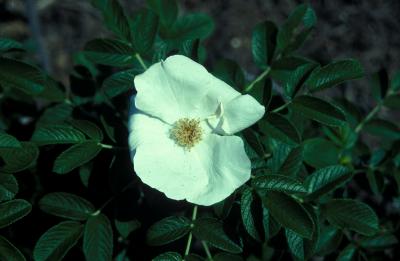Rose
White Rugosa Rose
Rosa rugosa alba
Features
Species Rugosa rose with distinctive crinkled foliage. Extremely hardy. Adapts to a variety of sites and shows good salt tolerance. White flowers, 3-4 inches wide (petal count 5), strong fragrance. Fall foliage color orange/red. Large orange/red fruit display in fall/winter.
Culture
Full sun, well-drained soil. Prune by the renewal method removing one-third of the oldest canes to the soil line in the spring as needed to keep the shrub open and new canes in production. Prune the stem back to a branch angle (a process called heading back) as needed to reduce width and height.
Cultivars
Mature Height
5-7 Feet
(Width 4 feet to 6 feet)
Size
Tall
USDA Hardiness Zone
2 - 8
Bloom Color
White
Bloom Season
June - August
Soil Conditions
Moist, Well-Drained
Exposure/Light Requirements
Full Shade
Pests and Problems
Environmental Damage
Insect Damage
Additional pests and problems that may affect this plant:
Excellent tolerance to blackspot. Watch for Japanese beetle, aphids, cane borer and rose midge.
Additional Notes
For best fruit display, do not deadhead. Don't use fungicides as they are phytotoxic and will result in foliage damage and loss.
Related Resources
Home, Yard & Garden Pest Guide
The Home, Yard & Garden Pest Guide (C1391) provides is written for homeowners and other residents and provides nonchemical and current chemical recommendations for controlling pests associated with trees, shrubs, turf, flowers, groundcovers, vegetables, fruit, and houses. In addition, you'll find detailed information about integrated pest management, pesticide safety, and pesticide application and calibration techniques. This publication may be purchased at your local University of Illinois Extension Unit office, or by calling 800-345-6087, or by placing an order online (search for "C1391").
Visit site >>
Illinois Commercial Landscape and Turfgrass Pest Management Handbook
The Illinois Commercial Landscape and Turfgrass Pest Management Handbook (ICLT) is written for professional applicators and provides nonchemical and current chemical recommendations as well as application timing information for all major pests of turf, woody ornamentals and herbaceous ornamentals. This publication may be purchased at your local University of Illinois Extension Unit office, or by calling 800-345-6087, or by placing an order online (search for "ICLT").
Visit site >>
U of IL - Distance Diagnosis through Digital Imaging
A free plant, weed, insect and disease identification service available through your local University of Illinois Extension office. Center Educators or State Specialists review & respond to information and digital images submitted by local Extension office personnel. Some samples may require further examination or culture work (nominal fee involved) at the U of IL Plant Clinic.
Visit site >>
U of IL - Plant Clinic
Services include plant and insect identification, diagnosis of disease, insect, weed and chemical injury (chemical injury on field crops only), nematode assays, and help with nutrient related problems, as well as recommendations involving these diagnoses. Microscopic examinations, laboratory culturing, virus assays, and nematode assays are some of the techniques used in the clinic.
Visit site >>
